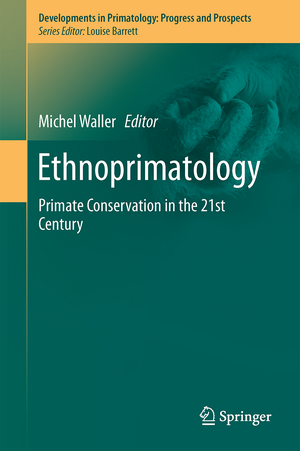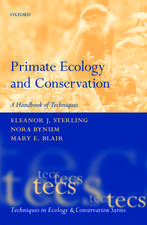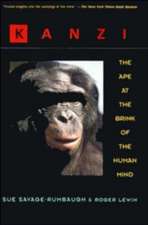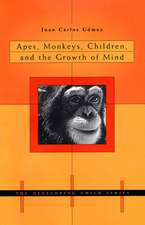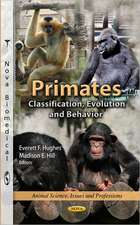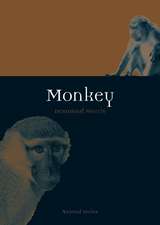Ethnoprimatology: Primate Conservation in the 21st Century: Developments in Primatology: Progress and Prospects
Editat de Michel T. Walleren Limba Engleză Hardback – 9 aug 2016
| Toate formatele și edițiile | Preț | Express |
|---|---|---|
| Paperback (1) | 1114.34 lei 6-8 săpt. | |
| Springer International Publishing – 7 iun 2018 | 1114.34 lei 6-8 săpt. | |
| Hardback (1) | 1120.50 lei 6-8 săpt. | |
| Springer International Publishing – 9 aug 2016 | 1120.50 lei 6-8 săpt. |
Din seria Developments in Primatology: Progress and Prospects
- 20%
 Preț: 571.32 lei
Preț: 571.32 lei - 18%
 Preț: 1216.65 lei
Preț: 1216.65 lei - 19%
 Preț: 578.67 lei
Preț: 578.67 lei - 18%
 Preț: 956.69 lei
Preț: 956.69 lei - 18%
 Preț: 948.92 lei
Preț: 948.92 lei - 18%
 Preț: 948.92 lei
Preț: 948.92 lei - 18%
 Preț: 945.79 lei
Preț: 945.79 lei - 18%
 Preț: 962.66 lei
Preț: 962.66 lei - 18%
 Preț: 1664.43 lei
Preț: 1664.43 lei - 18%
 Preț: 1224.54 lei
Preț: 1224.54 lei - 24%
 Preț: 826.26 lei
Preț: 826.26 lei - 24%
 Preț: 802.76 lei
Preț: 802.76 lei - 18%
 Preț: 1562.94 lei
Preț: 1562.94 lei - 18%
 Preț: 950.21 lei
Preț: 950.21 lei - 18%
 Preț: 943.73 lei
Preț: 943.73 lei - 18%
 Preț: 1549.67 lei
Preț: 1549.67 lei - 18%
 Preț: 1248.20 lei
Preț: 1248.20 lei - 18%
 Preț: 941.38 lei
Preț: 941.38 lei - 24%
 Preț: 800.87 lei
Preț: 800.87 lei - 18%
 Preț: 953.35 lei
Preț: 953.35 lei - 18%
 Preț: 1827.48 lei
Preț: 1827.48 lei - 18%
 Preț: 1209.52 lei
Preț: 1209.52 lei - 18%
 Preț: 957.62 lei
Preț: 957.62 lei - 18%
 Preț: 1231.47 lei
Preț: 1231.47 lei - 18%
 Preț: 1225.48 lei
Preț: 1225.48 lei - 5%
 Preț: 1433.83 lei
Preț: 1433.83 lei - 18%
 Preț: 1231.16 lei
Preț: 1231.16 lei - 18%
 Preț: 1226.90 lei
Preț: 1226.90 lei - 18%
 Preț: 955.25 lei
Preț: 955.25 lei - 18%
 Preț: 956.03 lei
Preț: 956.03 lei - 18%
 Preț: 1218.53 lei
Preț: 1218.53 lei - 18%
 Preț: 950.52 lei
Preț: 950.52 lei -
 Preț: 416.82 lei
Preț: 416.82 lei - 18%
 Preț: 1554.89 lei
Preț: 1554.89 lei
Preț: 1120.50 lei
Preț vechi: 1366.46 lei
-18% Nou
Puncte Express: 1681
Preț estimativ în valută:
214.43€ • 232.84$ • 180.12£
214.43€ • 232.84$ • 180.12£
Carte tipărită la comandă
Livrare economică 22 aprilie-06 mai
Preluare comenzi: 021 569.72.76
Specificații
ISBN-13: 9783319304670
ISBN-10: 3319304674
Pagini: 442
Ilustrații: IX, 422 p. 66 illus., 31 illus. in color.
Dimensiuni: 155 x 235 x 24 mm
Greutate: 0.78 kg
Ediția:1st ed. 2016
Editura: Springer International Publishing
Colecția Springer
Seria Developments in Primatology: Progress and Prospects
Locul publicării:Cham, Switzerland
ISBN-10: 3319304674
Pagini: 442
Ilustrații: IX, 422 p. 66 illus., 31 illus. in color.
Dimensiuni: 155 x 235 x 24 mm
Greutate: 0.78 kg
Ediția:1st ed. 2016
Editura: Springer International Publishing
Colecția Springer
Seria Developments in Primatology: Progress and Prospects
Locul publicării:Cham, Switzerland
Cuprins
Introduction.- 1. Ethnoprimatology and Conservation: Applying Insights and Developing
Practice.- 2. The Threat of Industrial Oil palm Expansion to Primates and Their Habitats.- 3. Monkeys on the Menu? Reconciling Patterns of Primate Hunting and Consumption in a Central African Village.- 4. Conservation Medicine: A Solution Based Approach for Saving Nonhuman Primates.- 5. How Do Primates Survive Among Humans?
Mechanisms Employed by Vervet Monkeys Lake.- 6. Indigenous Peoples, Primates, and Conservation Evidence: A Case Study Focusing on the Waorani of the Maxus Road.- 7. The Role of Nonhuman Primates in Religious and Folk Medicine Beliefs.- 8. Problematic Primate Behaviour in Agricultural Landscapes: Chimpanzees as "Pests" and "Predators".- 9. Competition Between Chimpanzees and Humans: the Effects of Harvesting Non-Timber Forest Products.- 10. The Effects of War on Bonobos and other Nonhuman Primates in the Democratic Republic of the Congo.- 11. Primate taxonomy and Conservation.- 12. Government and Community Based Primate Conservation Initiatives in Peru.- 13. Managing Human-Orangutan Relationships in Rehabilitation.- 14. The Little Fireface Project – Community Conservation of Asia’s Slow Lorises Via Ecology, Education, and Empowerment.- 15. The Many Facets of Human Disturbances at the Tonkolili Chimpanzee Site.- 16. How Living Near Humans Affects Singapore’s Urban Macaques.- 17. Risk-taking in Samango Monkeys in Relation to Humans at Two Sites in South Africa.- 18. Predicting Future Effects of Multiple Drivers of Extinction Risk in Peru’s Endemic Primate Fauna.- 19.
Protecting Nonhuman Primates in Peri-urban Environments: A Case Study of Neotropical Monkeys, Corridor Ecology, and Coastal Economy in the Caribe Sur of Costa Rica.- 20. Primates and People in the Zoo: Implications of Human-Animal Interactions and Relationships.- 21. Conservation: New Potential for Stable Isotope Analysis?.- Index.
Recenzii
“Each chapter shares a common structure, and the editor cross-references findings throughout the volume, resulting in a highly readable text. The volume shows the opportunities the ethnoprimatological perspective offers for maximizing ecosystem health for the future well-being of humans and non-humans alike. Summing Up: Highly recommended. Upper-division undergraduates and above; faculty and professionals.” (L. K. Sheeran, Choice, Vol. 54 (7), March, 2017)
Notă biografică
Dr. Michel Waller has over 15 years of experience researching primates in Africa. His field studies include chimpanzee/human interactions in Senegal and bonobo/human interactions in war-torn Democratic Republic of Congo. Dr. Waller studies primate socioecology and behavior in an effort to better understand the spectrum of factors that have shaped early human evolution. His research has focused on ranging behavior, territoriality, aggression, and tolerance.
Textul de pe ultima copertă
The list of challenges facing nonhuman primates in the 21st century is a long one. The expansion of palm oil plantations to feed a growing consumer class is eating away at ape and monkey habitats in Southeast Asia and Central Africa. Lemurs are hunted for food in the poorest parts of Madagascar while monkeys are used as medicine in Brazil. Traditional cultural beliefs are maintaining demand for animal body parts in West African markets while viral YouTube videos of “cute” and “cuddly” lorises have increased their market value as pets and endangered their populations. These and other issues are addressed in this book by leading researchers in the field of ethnoprimatology, the study of human/nonhuman primate interactions that combines traditional primatological methodologies with cultural anthropology in an effort to better understand the nuances of our economic, ritualistic, and ecologic relationships.
Caracteristici
Breaks down the subtleties of issues such as habitat loss and bushmeat hunting by going deeper into human motivations Critiques human behavior in zoos and looks at the factors leading to ape attacks on humans in the wild Brings humans into account as part of the ecologic landscape Includes supplementary material: sn.pub/extras
